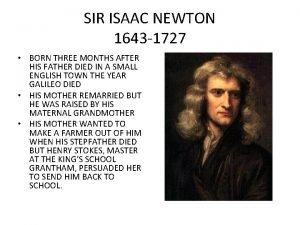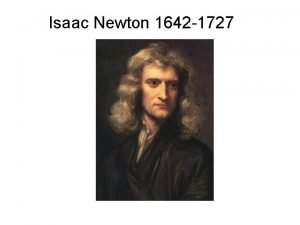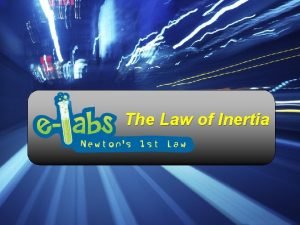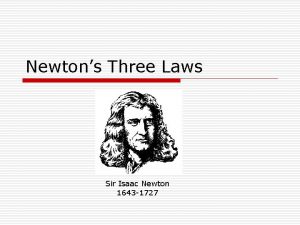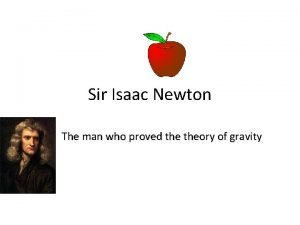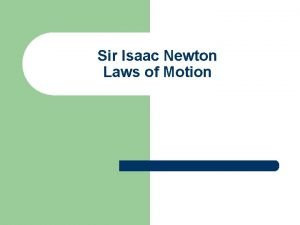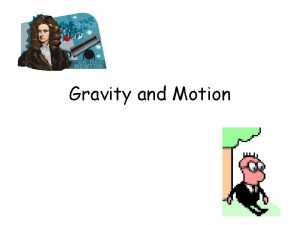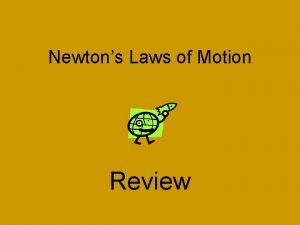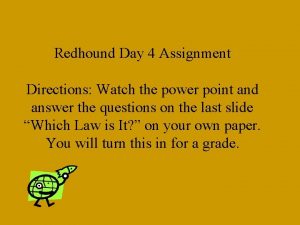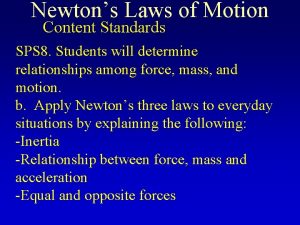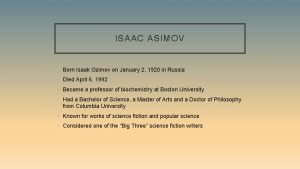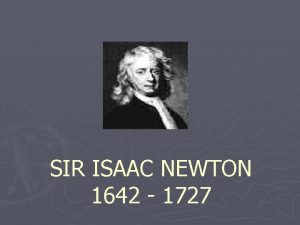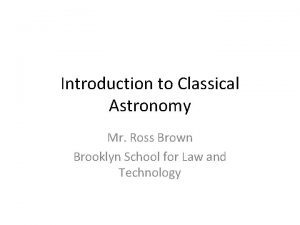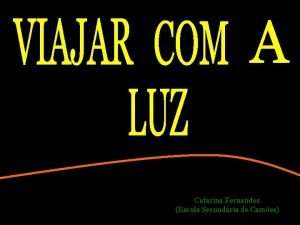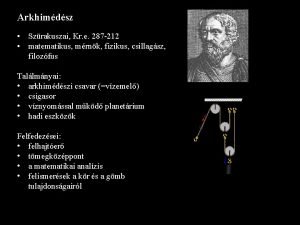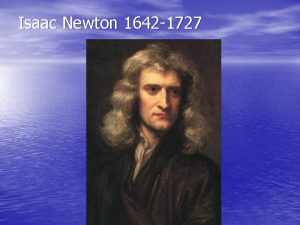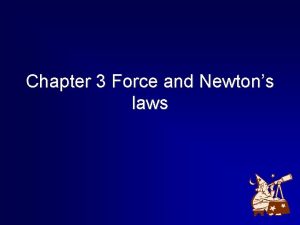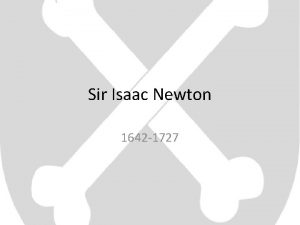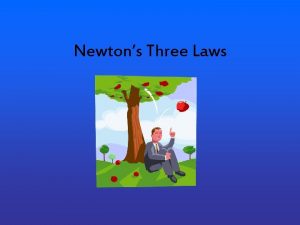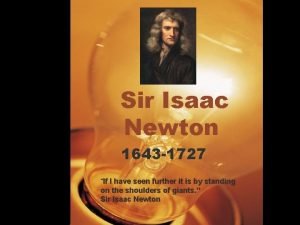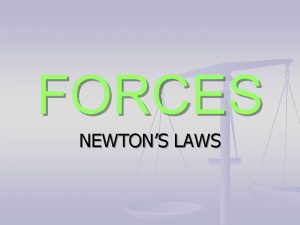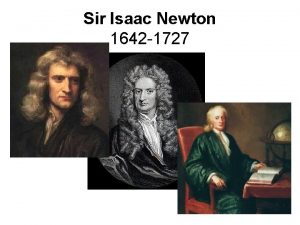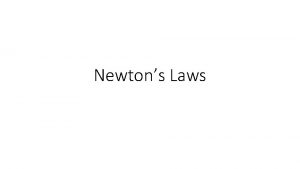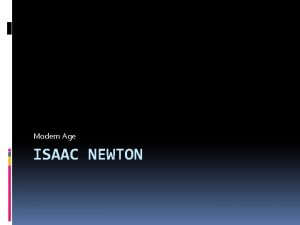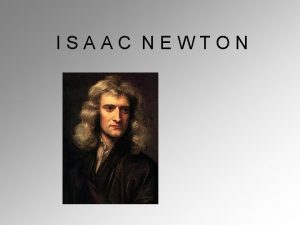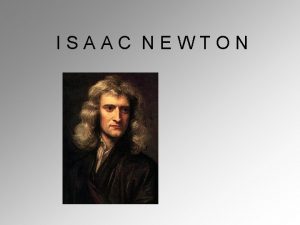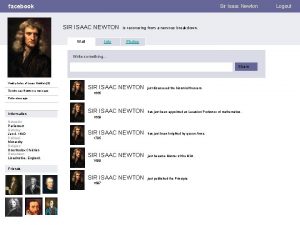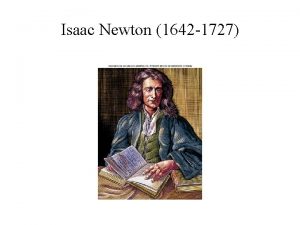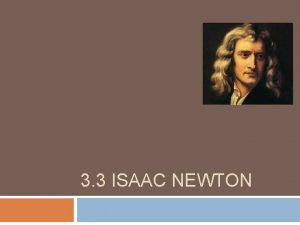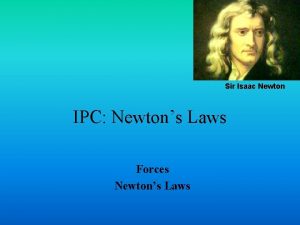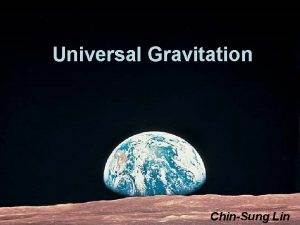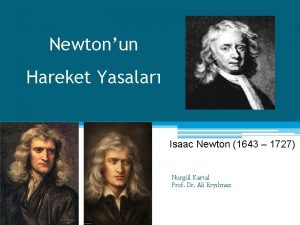Newtons Three Laws Sir Isaac Newton 1643 1727



























- Slides: 27

Newton’s Three Laws Sir Isaac Newton 1643 -1727

Introduction o Newton’s 3 laws define some of the most fundamental things in physics including: n Why things fall down n Why objects move n And much more!

First Law o Newton’s first law states that something in motion will continue in motion until acted upon by an external force. o This is also called the Law of Inertia.

First Law o That means that something moving would move FOREVER if another force did not act on it. o Think of a soccer ball being kicked. Do you know what force acts on it to bring it back down to earth?

First Law o The force that brings the soccer ball back down is: n Gravity If it weren’t for this force, when you kicked a soccer ball it would never stop flying and never come back down to earth. That would be the longest kick ever!

First Law o Take a look at the animation. Why does the person continue to move when the car stops? Source: http: //www. glenbrook. k 12. il. us/gbssci/phys/mmedia/newtlaws/cci. html

First Law o The person keeps moving because no force pushed on it. The force of the wall only acted on the car. Source: http: //www. glenbrook. k 12. il. us/gbssci/phys/Class/newtlaws/u 2 l 1 a. html

Second Law o Newton’s second law states that the Force of an object is equal to its mass times its acceleration. F=ma

Second Law o This law is so important because it allows for calculations to be made. With this law you can actually calculate how strong a force is. Let’s try a couple problems!

Second Law o Imagine you are riding on a sled. You are accelerating at a rate of 4 m/s² and have a total mass of 40 kg. What is the net force exerted? (Remember: F=ma) o The answer is 160 N. You get this answer by plugging in the values. F=ma F=(40 kg)(4 m/s²). Note: 1 N = 1 kg m F=160 N s 2

Second Law o Suppose you hit a 3 kg textbook with a net force of 15 N. What is the book’s resulting acceleration? (Remember: F=ma) o The answer is 5 m/s². You get this acceleration by plugging in the values. F=ma 15 N=3 kg(a) a=15 N/3 kg a=5 m/s²

Second Law o Look at the animation. Why do the elephant and feather hit the ground at the same time? (assume no air resistance) Source: http: //www. glenbrook. k 12. il. us/gbssci/phys/mmedia/newtlaws/efff. html

Second Law o The elephant and feather hit the ground at the same time because they have equal accelerations- gravity (9. 8 m/s²). o What will be different between the elephant and the feather when they hit the ground? Look at the following example.

Second Law o Let’s assume the mass of the elephant is 100, 000 kg and the mass of the feather is 1 kg. They both accelerate (due to gravity) at a rate of 9. 8 m/s². What is their net forces? n (elephant) (feather) F=ma F=(100, 000 kg)(9. 8 m/s²) F=980, 000 N F=(1 kg)(9. 8 m/s²) F=9. 8 N This means the elephant will hit the ground with a force 100, 000 times bigger than the feather. That will definitely leave a mark!

Third Law o Newton’s third law states that for every action there is an equal but opposite reaction. Source: http: //www. glenbrook. k 12. il. us/gbssci/phys/Class/newtlaws/u 2 l 4 a. html

Third Law o Look at the animation. This shows an action with an equal but opposite reaction. Source: http: //mw. concord. org/modeler 1. 3/mirror/mechanics/Newton. Cradle. html o Can you think of any other equal but opposite force pairs?

Third Law o Perhaps you came up with: n When a baseball hits a bat o The bat exerts a force on the ball and the ball exerts an equal but opposite force on the bat.

Third Law o Perhaps you came up with: n When you step from a boat to a dock o You can feel the boat drift backwards. This is because as we move the direction of the dock, the boat moves with in an equal but opposite force.

Third Law o Perhaps you came up with: n Shooting a gun o The force forward the rifle puts on the bullet is matches with the equal but opposite force backwards the bullet puts on the rifle. This is what causes the gun to recoil (kick).

In Conclusion o Newton’s Three Laws are important! o What does his first law state? n Newton’s first law states that something in motion will continue in motion until acted upon by an external force.

In Conclusion o Newton’s Three Laws are important! o What does his second law state? n Newton’s second law states that the Force of an object is equal to its mass times its acceleration. F=ma

In Conclusion o Newton’s Three Laws are important! o What does his third law state? n Newton’s third law states that for every action there is an equal but opposite reaction.

Webquest o Now it is time to apply what you have learned!

Webquest o Case: Your space shuttle from planet Newtonian made a crash landing on planet Earth.

Webquest o Case: On your planet, everyone floats. But on Earth everyone is stuck to the ground! And no one knows why!

Webquest o Task: King Martian has asked you to use the following internet sites and research Newton’s three laws. Then, fill out the corresponding worksheet and (according to the teacher’s instructions) create a presentation.

Webquest o Links: n http: //teachertech. rice. edu/Participants/louviere/Newton/ n http: //www. bbc. co. uk/history/historic_figures/newton_isaac. shtml n http: //www. sciencenetlinks. com/interactives/gravity. html Best of luck!
 Isaac newton 1643 a 1727
Isaac newton 1643 a 1727 Isaac newton 1643 a 1727
Isaac newton 1643 a 1727 Isaac newton 1642-1727
Isaac newton 1642-1727 Newton's 3 laws names
Newton's 3 laws names Inertia in daily life
Inertia in daily life Newton's three laws
Newton's three laws Sir isaac newton
Sir isaac newton Isaac newton laws of motion
Isaac newton laws of motion Sir isaac newton
Sir isaac newton 3 laws of motion by isaac newton
3 laws of motion by isaac newton Gracia asombrosa en español
Gracia asombrosa en español Motion examples in everyday life
Motion examples in everyday life What are the 3 laws of motion
What are the 3 laws of motion Newton's three laws
Newton's three laws Newton's first law example
Newton's first law example Sir isaac asimov
Sir isaac asimov (1642-1727)
(1642-1727) Que es ciencias
Que es ciencias (1642-1727)
(1642-1727) (1642-1727)
(1642-1727) (1642-1727)
(1642-1727) Kr e 287
Kr e 287 1727
1727 Newton's law
Newton's law Acceleration due to gravity
Acceleration due to gravity Newtons 3 rd law
Newtons 3 rd law Third law of newton
Third law of newton Section 3 using newtons law
Section 3 using newtons law
